Table of Contents
Chapter 01
Role of design in society
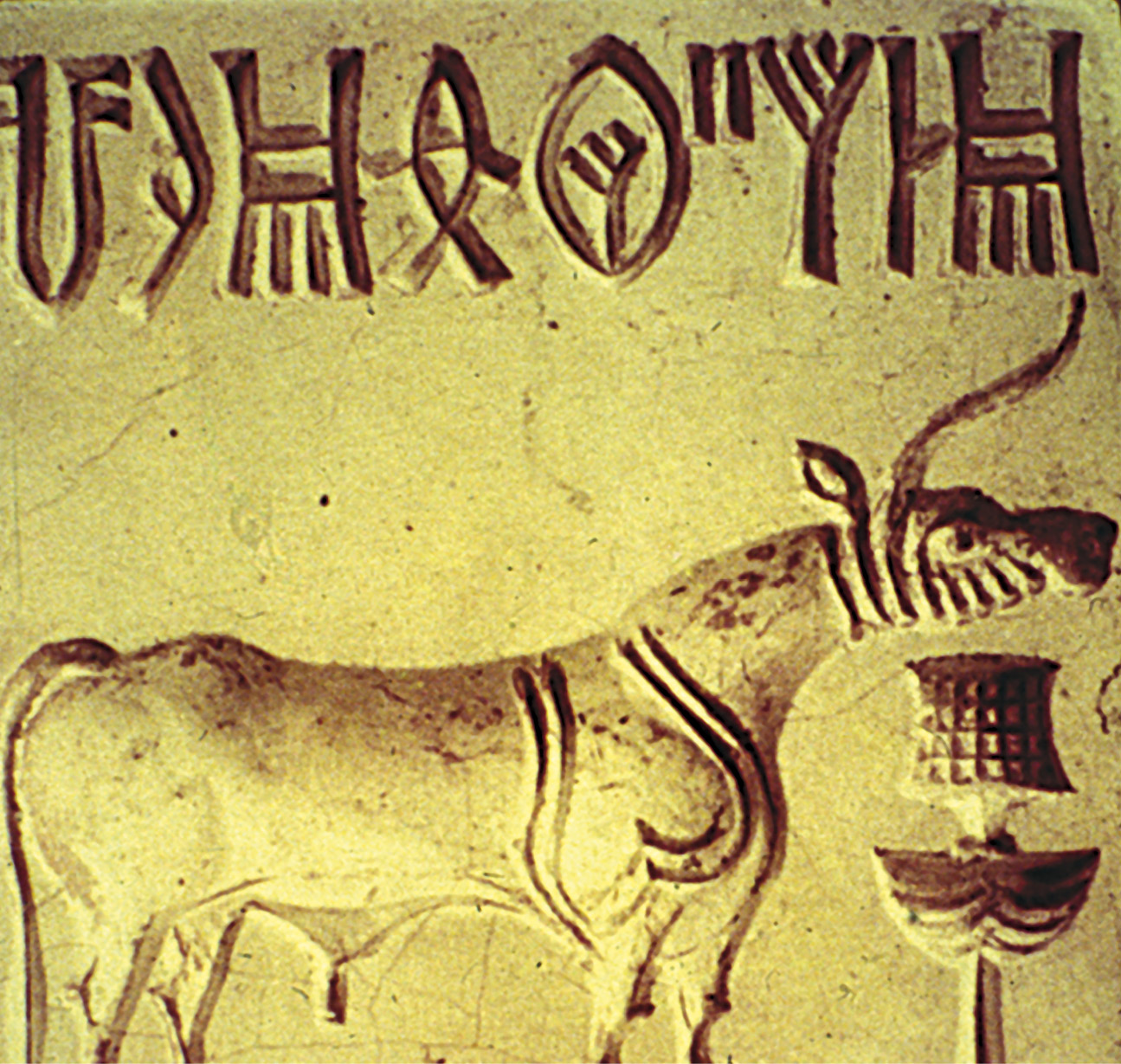
The way we understand design and the role of a designer in the contemporary society is an outcome of industrial revolution which led to mechanisation of the workforce through the use of machinery. The design as a specialised field of activity has evolved over a period of time. However, apart from its industrial role we now discuss design within the ambit of cultural, social and economic phenomena where the designer plays a significant role.
Therefore, design could be understood as a form of human intervention to make our surroundings more hospitable–the denominators of which are arbitrary and change from context to context.
To look at the world from the point of view of a graphic designer, we can develop a visual metaphor for our world within which a graphic designer operates. Since it’s a visual metaphor one sees the world made up of dots, lines, shapes, spaces and so on. As humans we occupy space – physical, mental and virtual. All our interactions take place within these spaces, be it institutional, natural, cultural, sacred, public or private.
Designers experience space not as a mere canvas, but as a dynamic entity waiting to be creatively filled. As a heterogeneous entity already layered with concepts, ideas and formulations that is central to the idea of ‘creativity’— urban/rural, ritualistic/secular, utopian/heterotrophic, public or the private.
So a space is always creative and so to say “designed”. And we as occupants of that space are always subjected to those designs. We as individual or groups or as members of the society are the occupants of this space as well as users of these designs. Design is everywhere. It is around us in various forms such as zebra crossings, barricades, road signs, rituals, and so on. Design, in the contemporary society is all pervasive, an omnipresent phenomenon. We easily associate design with popular media of correspondence like advertisements, various forms of entertainments, TV serials, pamphlets, posters, signage, and hoardings.
Did you know?
Are you familiar with the image on the left page?
This is a seal from the Indus valley civilisation which has the images of both a full, as well as calligraphic text (not deciphered so far by historians).
But have we ever tried to find out why modern cities are designed say in the form of a grid or the kind of drills we go through in a physical education period or say the paraphernalia of security barriers, surveillance cameras or the array of bumpers in front of ministerial places and government offices? Can we see graphic or visual patterns in all of them? All of these present before us certain sets of information through various signs and symbols. These designs not only serve the purpose passively and mechanically but there are many layers of hidden meanings associated with them. Since a graphic designer is a creator of such designs, one is expected to understand what is hidden underneath the surface, understand the functions of design and their impact and implications at surface level as well as at various levels of human existence.
Functions of Design
Design has manifold applications and usages ranging from the most obvious or surface-level usages to the most subtle and indirect usages that have far-reaching and deeper level impact. The significance of design lies in its ability to fulfil these demands whether aesthetic, telelogical or semiotic. By aesthetics, it is broadly understood as its sensory and beauty values i.e. concerned with the judgment of visual taste, here it is meant as the sensory appreciation of graphic design. While by functionality it is meant that the practical aspects of a given graphic design such as usability,
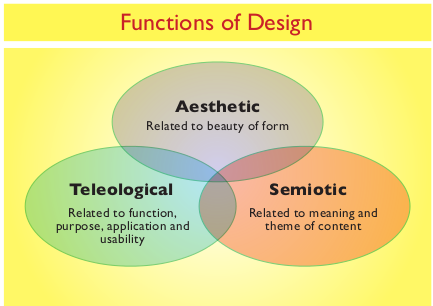
communicability, readability and making an impact and its efficiency lies in its ability to do so. Design has function as well as some purpose. In theoretical terms ability of design to fulfil the function or purpose is called ‘teleology’ of design. Apart from the above two, there is one more aspect of design called ‘content’ or meaning of design that can be broadly called as semiotic value of design.
A simple discussion might elaborate this case food has taste that caters to our taste buds which is a sensory quality of food. Sometimes the colour of food is attractive therefore we like it and some other times we get attracted towards it because it is arranged in a beautiful manner. Aroma, taste and decoration or garnishing cater to our sensory expectations.
Food also has nutritional value that is concerned with supplying energy to the body that helps in its overall physical growth and maintenance of general health and work efficiency and at times such food may not be visually attractive.
Now if the food is cooked by a mother, sister or wife, then it has a special meaning and highly personal significance attached to it. At times it may not be nutritious and properly decorated. Still the food will have its own unique significance which is the semiotic value of the food.
The illustration (above) is just suggestive since in reality a good food will have all three components in it. For example, when a mother prepares a special dish for her children she is concerned about its taste; its nutritional contents as well as she will serve it to her children with due care, love and affection.
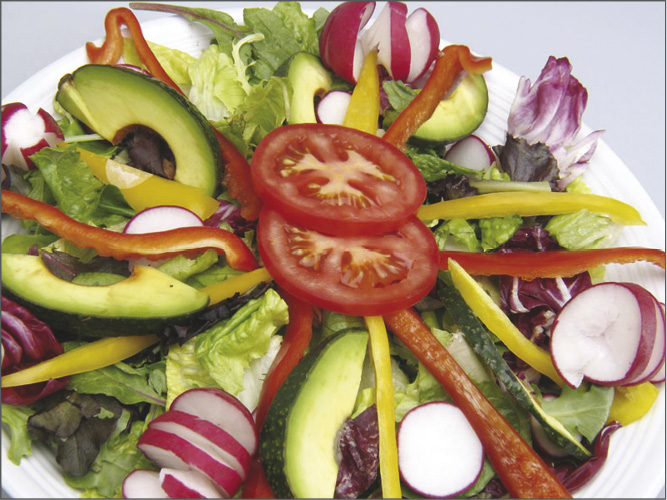
Activity 1
Pick up five designs from your surroundings and analyse their aesthetic, functional and semiotic characteristics.
Let us take another example. If there is a signage system for a sports event such as the Olympics games or the Asian games to be designed then while designing such a system, a graphic designer has to consider the above-mentioned aspects of design: form (aesthetics), function (teleology) and the content (semiotics). For instance while designing the signage for sports such as hockey, football etc. the visual symbols should be properly designed in the given space. Each dot, line or shape should look beautiful and properly composed. It should be visually balanced and very neatly and beautifully done. Also, there is a series of such symbols then a designer has to maintain a visual consistency among all the symbols. These are the formal aspects of a signage – the ‘aesthetics’ of a signage system.
Apart from that the main function of the sign is to communicate the message and the users should be able to recognise the particular sport easily as well as the signage should be able to guide the users. This is the functional aspect of the signage – ‘teleology’ of the signage system.
Any sports event and especially events such as the Olympic games is organised to spread the spirit of sportsmanship, peace and harmony. Now while designing the signage the graphic designer has to take care of the spirit of the games, its history and its socio – cultural significance that can be properly expressed through appropriate colour schemes, and suitable style of depicting visual elements such as dots, lines, shapes etc. In other words a graphic designer has to develop an appropriate visual language suitable for the theme or the content. This is the semiotics of the signage system.
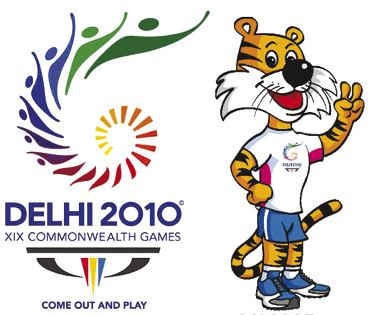
Official logo and mascot
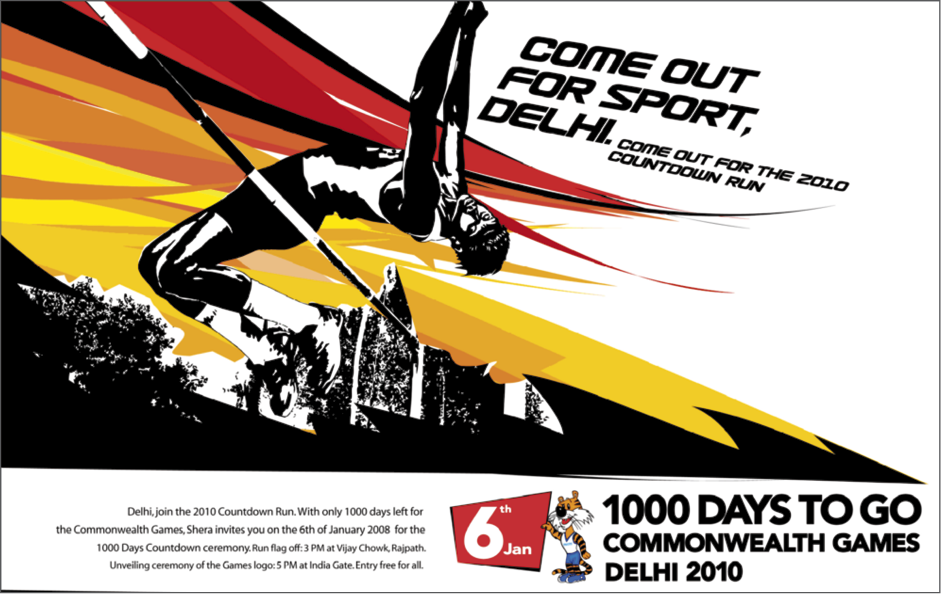
Implications and Impact of Graphic Design
A graphic designer is always aware about the formal beauty or aesthetic value, functionality, communicability or utilitarian value and semiotic value of the meaning of a design at an intuitive level. However, a professionally trained graphic designer uses these components with a knowledge and in a more sophisticated way.
Aesthetics has always been associated with artistic activities, like in graphic design, the way the individual elements are organised within a compositional space to achieve the organic unity, like dots, lines, colours and shapes are a all part of its design that create the desired look or expression that the creator tries to fulfil.
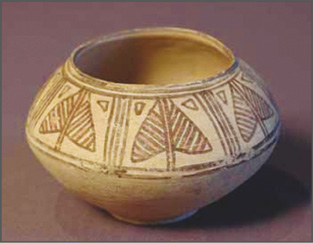
This earthen pot from Indus Valley Civilisation has beautiful decorated patterns. These patterns have strong graphic appeal, which reflect the aesthetic taste of the Indus people
We are often amazed by a certain ornamentation being drawn or incised on a mud pot or a water container, yet these marks may not have any bearing on the functionality of the object, but plays a role in the overall visual appeal. Sensory perceptions not only have a passive decorative purpose but have other key functions to serve – they are handy tools of attraction, desire generation in a competitive market place. In the contemporary world of retail marketing, for instance, beauty and the visual appeal, styling go a long way in giving a particular product an edge over the others. Also the overall look or styling of a particular product or service goes a long way in determining its socio — economic placement-the economic strata that the product or service caters to. So the sensory appeal plays an important role in creation of brand identity.
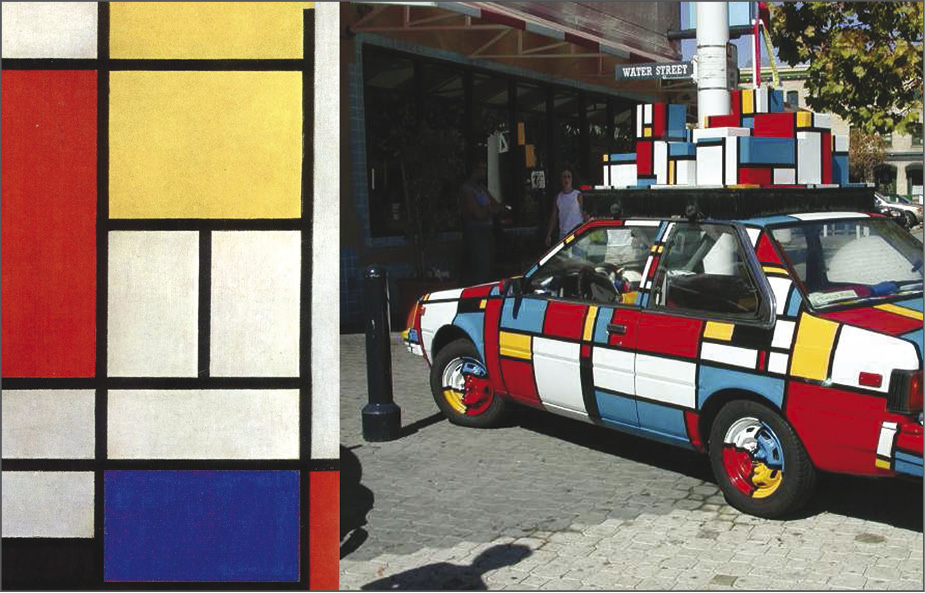
An oil painting on canvas by artist Mondrian Pierre and a popular example of the use of graphic elements in the commodities of day-to-day usage
Teleological or the functional concerns are at the core of any design choice as far as the user is concerned. User will not accept a design if it does not serve the purpose. For example, a poster design is supposed to make an impact even from a distance. If the user has to go close to the poster for reading and understanding a message then the user will not accept such a design. A graphic designer has to build the hierarchy of slogans, captions and other textual matter while designing a poster. The main message or slogan should be prominently visible from the desired distance. It should have an impressive type face with a large size. Secondary, captions can have medium size fonts while there can be a reading text in small type face. The user can always go closer to the poster and go through the details if he/she wants to know more about the message. Similarly, a graphic designer should build a visual hierarchy of images, illustrations and other visuals to supplement the desired impact of a poster. This applies to all types of graphic designs.

A well designed poster
Similarly, semiotic qualities of a design, such as a theme or a poetic idea behind the design make it meaningful for the user. Users are attracted towards a good design, because many a times it appeals to some socio-cultural concern. At times the design has an historical value, a ritualistic value or traditional value. If a design carries certain features from a particular tradition then the user familiar with that tradition will have empathy for the design. For example, one can see features of Warli paintings, style of expression among the Warli tribe of Maharashtra, in modern designs such as greeting cards, lamp shades, costumes etc. People having affinity for Warli style will be attracted towards the design.
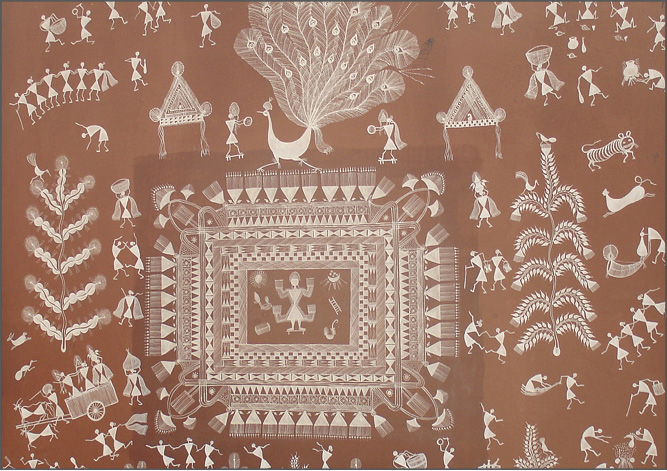
Therefore, these three components — aesthetics, teleology, and semiotics are complementary to each other. Design is a tool, a tool in the hands of a designer to fulfil certain specific needs or to reach specific target audiences. And to do that one of the minimum criterions’ that it has to achieve is to communicate, communicate with the target user at large. This is possible with appropriate integration of aesthetics, teleology, and semiotics. Most of the times, the integration or blending of aesthetics, teleology, and semiotics in a design is seamless. It is very difficult to isolate these three forms with each other. The common user or the target audience is unaware about these three because their blend produces tremendous impact on them and the user never notices it.
Strategic use of graphic design as a popular media often promote certain ideologies. It points to the persuasive potential of communication strategies designed by the best brains and best graphic designers. Seamless blending of aesthetics, teleology and semiotics take full advantage of selection of corporate spokespersons, visual logos, audio jingles, catchy slogans, the style and pace of commercials, special technical effects, editing conventions, product packaging and the melding of prints and electronic media, to name several central factors that are combined to generate the desired result. Social mediation talks about how mass media representations are recognised, interpreted, edited, and used in audience member’s social construction of daily life. This is a very common occurrence in our social interactions while we often use media infested slogans and imageries. To a great extent media is generating ideas that are purely hypothetical. However, the society starts believing in them and try to manifest them in real life. Media is no more a reflection of society. On the other hand, many things in the society are reflections of media imagery.
Graphic Design enters into even the most unexpected of domains — body and health. We uncritically talk about healthy and perfect body and pass of the desirable as something natural with pretensions of scientific objectivity when in reality it is designed — a look into the history of body will be testimony to the fact that what is desirable as “perfect” or healthy or beautiful has been a variable from culture.

Contemporary Graphic Design
Especially, after the post-modern era and more specifically, after post-liberalisation in India the scenario has greatly changed. A new philosophy has emerged that the desires are manufactured through a whirlwind of signs, symbols, metaphors, graphics and all sorts of imagery. In addition to it there are now tools and technologies of New Media that are highly effective and equally user-friendly. Due to these technologies every individual feels that one can play with graphics and as a fall out there is a new generation of graphic designers. Therefore there is a need for thorough training and sensitisation towards design since such designers are everywhere and designing and developing print material as well as digital materials like, multimedia CD ROMs and web sites. Contemporary philosophical thinking is highly appealing and therefore a contemporary graphic designer should be aware about the consequences of their design decisions.
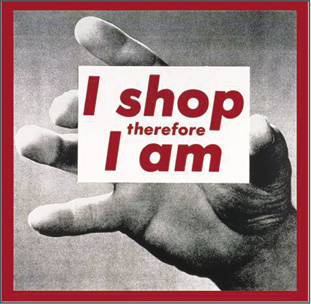
All pervasiveness of new age philosophy could be evidenced not only in the more celebrated components of our daily routine needs such as a designer wear or the sleek furnishing of an automobile to the various forms of promotional devices that rules our tastes in the name of choice through window displays of retail outlets to the random confrontation of hoarding posters and banners that our day to day existence, and with them a certain lifestyle and philosophy of existence. Design penetrates to the more commonplace of our daily activities and social interactions from the gestures and postures we adopt in the public and the private.
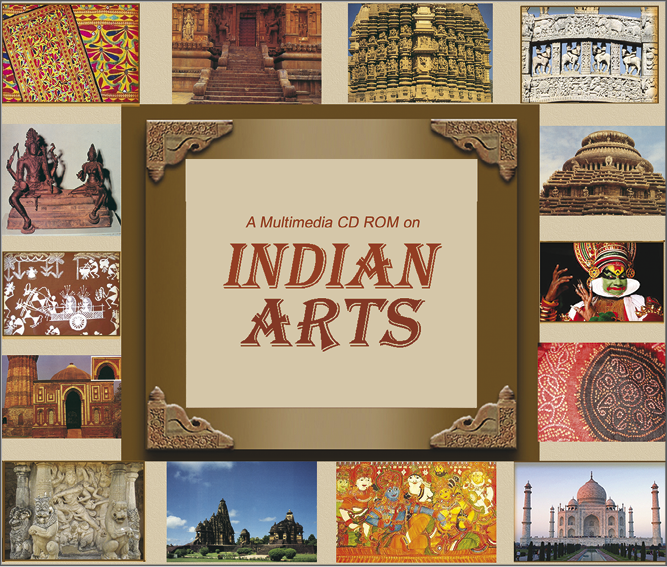
As a testimony to the present day society designs pre-eminence as a tool, a tool in the production of ideology becomes more and more evident.

Innovative use of the image of ‘Natraja’ used on a modern T-Shirt design
In the twenty-first century we are faced with graver challenges, that has the potential of ending human occupation on earth and that is the spectre of global warming and environmental degradation.
This is caused by our indiscriminate use of natural resources that comes with a growing population and increasing energy consumption. It is a fallout of industrial revolution bound with notions of progress and individual choices of freedom. How to stop this? How to stop nature from turning against us, threatening our very own existence?
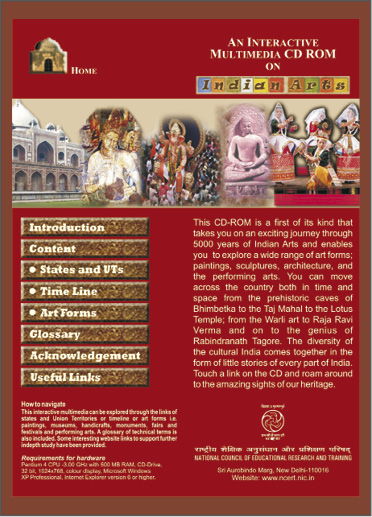
Activity 2
Graphic design and designers have a responsibility towards society and environment, Therefore, in this exercise you will pick up social issues such as child labour, female foeticide, global warming, domestic violence, etc. and create posters. You will start by collecting information from both primary and secondary sources, make thumbnail sketches and translate the most powerful idea into final design which should reflect your effort to bring a positive change in the society.

A poster to discourage child labour
For this, graphic design has to be more responsible, responsive to the surrounding environment and sensitive to the ecological balance of the world.
This brings us to one of the major challenges that graphic designers are facing at present — to design services, objects and spaces that minimise energy consumption and harmful waste outputs.

So optimising materials and eco friendly design becomes the new buzz word. The keywords become sustainability, recyclables, minimum energy consumption and waste management. Instead of all encompassing macro growth we need to look into self-sufficient sustainable units.
Role of the Graphic Designer
Looking at varied functions of design and its impact and implications, a designer in general and a graphic designer in particular can play a seminal role in resolving contemporary design issues. Graphic designers generate graphics for variety of things mostly either for print media or for digital media. This is usually done on a task basis if you are a freelance graphic designer and if you are employed in a graphic design firm then it will be a part of your routine activity.
Activity 3
As a designer how can you make your design eco-friendly?
Give five suggestions.
Here at every instance a graphic designer should always think about the larger concerns of design and society. Designers must be able to work under extreme time constraints and much defined financial conditions and still should be able to produce quality work.
In a large corporate set up a graphic designer must be able to understand and synthesise all the inputs received from number of people such as technical experts, marketing personal, managers and policy makers as well as visualises and other co-designers. Graphic designer’s also have to understand user research feedback prepared by the marketing department and cost specifications determined by the budgeting department. Apart from these not so creative tasks, a graphic designer has to prepare variety of sketches and models that demonstrate different approaches to the concept and prepare effective presentations. Therefore, a graphic designer also needs excellent communication skills. Designer should be able to understand feedback and comments and should have a good eye for aesthetic design, and a solid understanding of the needs of the corporate world.
The designer faces an ideological dilemma at every juncture. The corporate world has its own interests. A designer has to take a call on various larger issues of design concerns and social concerns.
If a designer is freelancing then he or she is likely to have a specialisation in a particular area of design such as, packaging design, illustration, calligraphy, typography, or web graphics. The designer can make an impact as a freelancer by carefully strategising design philosophy and integrating it with professional requirements.
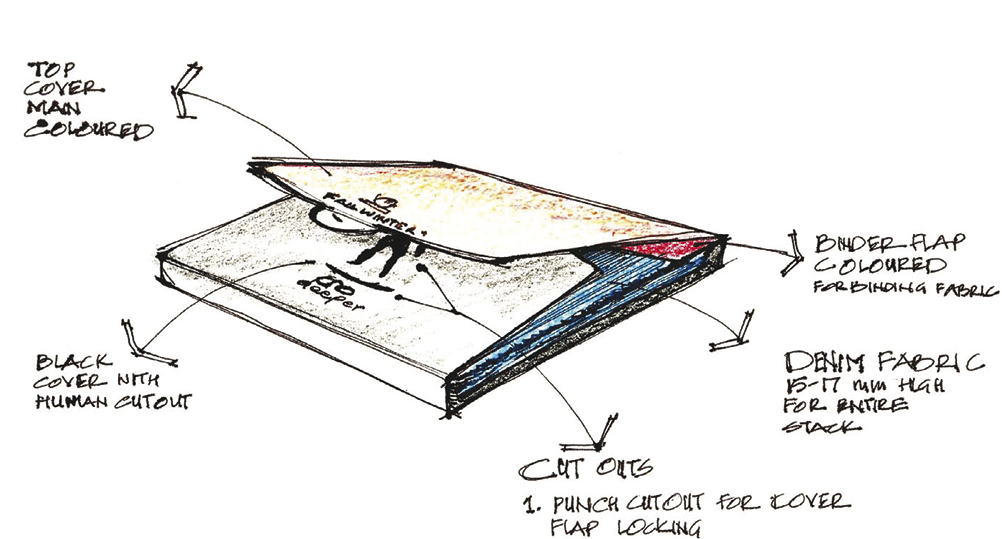
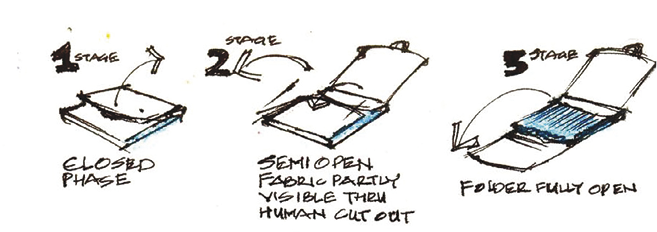
A graphic desiger can make a presentation through sketches
A successful graphic designer has an enviable life, choosing clients and earning significant amounts of money. However, a freelancer needs to keep with the current trends in the profession since whatever is acceptable today in the industry may not be acceptable the next day. This is also true for the individual style. Therefore, a graphic designer needs to develop a skill-set that is versatile and all comprehensive. Super-specialisation should be avoided as far as possible. Apart from developing certain skill-set what is more important is the overall orientation of the designer — as a designer and as a human being. As already described, a designer has to struggle and has to work under constraints of time and finance as well as one has to interact with variety of stake-holders in the profession. In such a scenario, maintaining an individual identity, adhering to the larger design concerns is a challenge. Every designer faces these challenges and develops a strategy to tackle them. A graphic designer with a robust design philosophy can make historical contribution to the field of design.
Exercise
1. According to you, why is it important for a graphic designer to create designs keeping in mind the cultural ethos of the society?
2. What are the three aspects of design? Explain with the help of your own examples.
3. Why is it important that a design consists of all three aspects- aesthetic, teleology and semiotics?
4. In your opinion what would happen if the design is functional but not aesthetic.
5. Write your views on all pervasiveness of design.
6. In the contemporary scenario a Graphic designer be a specialist or a generalist. Give your views.